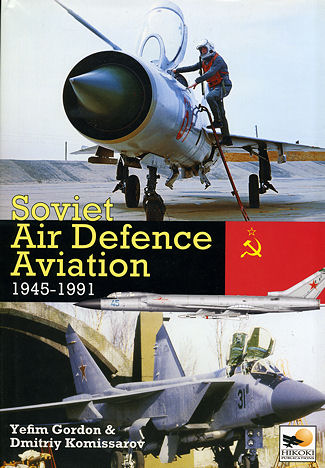 Continuing
on their series on Soviet and Russian aviation, Gordon and Komissarov have
produced this volume on Soviet Air Defense. This one covers the years from the
end of WWII until the break-up of the Soviet Union; basically what we call the
Cold War.
Continuing
on their series on Soviet and Russian aviation, Gordon and Komissarov have
produced this volume on Soviet Air Defense. This one covers the years from the
end of WWII until the break-up of the Soviet Union; basically what we call the
Cold War.
As with previous volumes, this one is divided into time
sections, starting with the end of WWII until the 1950s. This was a period of
transition from props like the La-9/11 into the first jets. These were basically
the Yak German-derived designs and the La-15, which was removed from production
once the MiG-15 came into being. Not because of faults with the airframe, but
because the La-15's engine was based on German technology while the MiG-15 had
the British derived RD-1.
It is interesting to note that the various time periods were
generally devoted to certain aircraft types. For instance, the time from 1950 to
1960 was the time of the MiG 15/17/19 as well as the long range Yak-25. The next
period of the 60's and 70s were MiG-21s, other Yak-25 variants, the Tu-128 as
well as the MiG-23 and the very fast MiG-25. In this mix were also various
Sukhoi designs like the Su-9/11 and Su-15. The last section covers the MiG-31
and Su-27s as the really new types. Of course, many of these aircraft
transcended these time frames so it wasn't as if a decade ended and types were
scrapped.
During these times, the weapons carried by these aircraft
changed from the all gun armament in the first years to more and more potent
missiles. I found it interesting that some types, like the Sukhois, Tu-128s and
MiG-31s were strictly air defense interceptors and not used by any other part of
the Soviet Air Force, unlike the MiG-14/17/21, which were also used as ground
attack aircraft.
In addition to describing the types in use, much of the book
covers various incidents where Soviet airspace was either purposely or
accidentally invaded. Tales of Turkish F-100s swooping in a low level over
Soviet bases before retreating at max thrust back to Turkish air space as well
as Iranian spy flights were some of the stories I found fascinating. Of course,
there was the usual Western flights of U-2s, SR-17s, RB-29s, RB-47s and a host
of other snooper types. It is refreshing to hear of the intercept stories told
by ex-Soviet pilots as in the West we usually only get one side of these sorts
of stories.
Other sections of the book cover the two major incidents were
Korean airliners were either shot down or force landed. A full listing of all
the different types used by Air Defense Aviation are also covered as are the
missiles that were used.
In all, it makes for a superb study of what was probably the
largest aircraft air defense network in the world. This is not a book you can
simply breeze through. Like all of Hikoki books on similar subjects, it has been
well researched and makes for a great read. It is chock full of photos of the
aircraft in question as well as some of the more important personalities. A book
that I thoroughly enjoyed reading and can most highly recommend to you. Purchase
this one with confidence.
December 2012
Review book courtesy of
Specialty Press,
where you can order your copy of this and many other superb aviation and
modeling books. Visit their website at the link above or call them at
1-800-895-4585
If you would like your product reviewed fairly and quickly, please contact
me or see other details in the Note to
Contributors.
 Continuing
on their series on Soviet and Russian aviation, Gordon and Komissarov have
produced this volume on Soviet Air Defense. This one covers the years from the
end of WWII until the break-up of the Soviet Union; basically what we call the
Cold War.
Continuing
on their series on Soviet and Russian aviation, Gordon and Komissarov have
produced this volume on Soviet Air Defense. This one covers the years from the
end of WWII until the break-up of the Soviet Union; basically what we call the
Cold War.